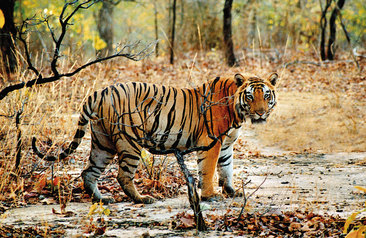About Royal Bengal Tiger
Bengal TigerSince the era of gods and goddesses, Tiger has been of great importance in India. It has been mentioned in every myth, epic and literature. The only place where Royal Bengal Tiger is found is the land of natural heritage, India.
The Bengal Tiger is native to the Indian Peninsular. It also lives in Bangladesh, Nepal, India, Bhutan and in Burma. A powerful hunter with sharp teeth, strong jaws, and an agile body, the Royal Bengal Tiger is the largest member of the cat family. It is also the largest land-living mammal whose diet consists entirely of meat. Its length can measure up to 10 feet and has a weight ranging from 180 to 260 kgs. Following are the details of Royal Bengal Tiger.
Latin Name of Bengal Tiger: Panthera tigris
Length :
Males: 8.8 feet-10.2 fee
Females: 7 .11 feet - 8.7 feet
Weight:
Males: 419-569 pounds
Females: 221-353 pounds
Diet: Consists of pigs, deer, antelopes and buffalo.
Habitat of Bengal Tiger
The habitat of this exquisite Tiger varies from the largest estuarine delta Sundarban, which is the biggest colony of the `Royal Bengal Tigers' to the desert land of Ranthambore, from the magnificent hills of Himalayas to Bandipur in the peninsular India.
The Royal Bengal Tiger - The Endangered Species
The Bengal tiger is endangered from loss of habitat. It's estimated that less than 3,000 Bengal tigers are left in the wild today. In India we had over forty thousand tigers in the beginning of the 20th century, but the number has decreased considerably. For example, the authorities of the Buxa Tiger Reserve in North Bengal estimated the number of Royal Bengal tigers in the reserved areas as 32, as per the census in 1997, a notch above the figure of 31, as per the 1995 census. The reasons for tiger becoming an endangered species are uncontrolled cutting of trees resulting in the shrinkage of the habitat of the tiger, decrease of preys and an increase of poaching for its beautiful skin. To stop this and to increase the number of tigers, Government of India initiated the 'Project Tiger' in 1973, when the number of tigers in India was less than 2000. This project entailed the creation of nine tiger reserves, now this number has increased.
Due to above measures, it can thus be seen that out of five surviving sub-species of tigers, the position of the Bengal tiger animal is the most satisfactory and India accounts for 75 per cent of the species, which is roughly 60 percent of the global population of all tiger sub species put together.
The Royal Bengal Tiger animal lives in varied habitats open jungles, humid evergreen forests and mango grove swamps. Its diet consists mainly of deer, antelopes, gaursand wild pigs. Sometimes it also captures birds, lizards, turtles, fishes, frogs and crabs. Royal Bengal Tigers hunt on their own and usually lead a solitary existence, each in its own territory.
Characterstics of Bengal Tiger
Tigers lead solitary lives, and the courtship period, and association between mother and cub is their only interaction and association. Tigers are entirely different in their hunting habits from lions, and hence they are mutually exclusive in their distribution. Tigers rest during the day in the shade, and begin to hunt for food at dusk. They have keen eye sights and a sharp hearing that helps them stalk their prey. Tiger killings are split second affairs where the prey hardly has any chance of survival. Its formidable and retractile claws play a significant role in capturing and holding on to its prey.
Tigresses are devoted mothers who are very protective of their cubs. They look after their young till they are about two and a half years old.

























.jpg)
0 Comments